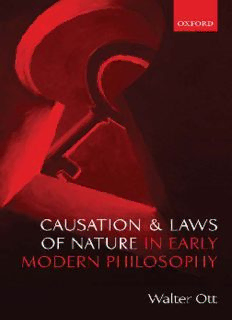
Causation and Laws of Nature in Early Modern Philosophy PDF
Preview Causation and Laws of Nature in Early Modern Philosophy
CAUSATION AND LAWS OF NATURE IN EARLY MODERN PHILOSOPHY This page intentionally left blank Causation and Laws of Nature in Early Modern Philosophy WALTER OTT 1 1 GreatClarendonStreet,Oxfordox26dp OxfordUniversityPressisadepartmentoftheUniversityofOxford. ItfurtherstheUniversity’sobjectiveofexcellenceinresearch,scholarship, andeducationbypublishingworldwidein Oxford NewYork Auckland CapeTown DaresSalaam HongKong Karachi KualaLumpur Madrid Melbourne MexicoCity Nairobi NewDelhi Shanghai Taipei Toronto Withofficesin Argentina Austria Brazil Chile CzechRepublic France Greece Guatemala Hungary Italy Japan Poland Portugal Singapore SouthKorea Switzerland Thailand Turkey Ukraine Vietnam OxfordisaregisteredtrademarkofOxfordUniversityPress intheUKandincertainothercountries PublishedintheUnitedStates byOxfordUniversityPressInc.,NewYork ©WalterOtt2009 Themoralrightsoftheauthorhavebeenasserted DatabaserightOxfordUniversityPress(maker) Firstpublished2009 Allrightsreserved.Nopartofthispublicationmaybereproduced, storedinaretrievalsystem,ortransmitted,inanyformorbyanymeans, withoutthepriorpermissioninwritingofOxfordUniversityPress, orasexpresslypermittedbylaw,orundertermsagreedwiththeappropriate reprographicsrightsorganization.Enquiriesconcerningreproduction outsidethescopeoftheaboveshouldbesenttotheRightsDepartment, OxfordUniversityPress,attheaddressabove Youmustnotcirculatethisbookinanyotherbindingorcover andyoumustimposethesameconditiononanyacquirer BritishLibraryCataloguinginPublicationData Dataavailable LibraryofCongressCataloginginPublicationData Ott,WalterR. Causationandlawsofnatureinearlymodernphilosophy/WalterOtt. p.cm. Includesbibliographicalreferencesandindex. ISBN978–0–19–957043–0(alk.paper) 1. Causation.2. Philosophyofnature.3. Necessity(Philosophy)4. Naturallaw.I. Title. BD541.O832009 122.09’032—dc22 2009016665 TypesetbyLaserwordsPrivateLimited,Chennai,India PrintedinGreatBritain onacid-freepaperby MPGBooksGroupLtd,King’sLynn,Norfolk ISBN978–0–19–957043–0 1 3 5 7 9 10 8 6 4 2 Acknowledgments Likeanyoneworkingonabigproject,Ihaveamassedanumberofdebts.Ihope mylistiscomplete. My first debt is to Steven Nadler and Donald Rutherford, whose 2004 National Endowment for the Humanities Summer Institute, ‘The Intersection of Philosophy, Science, and Theology in the Seventeenth Century,’ at the University of Wisconsin–Madison, pointed me in a new direction. I thank the presenters and participants, particularly Michael LeBuffe, Mary Domski, MichaelJacovides,andMartinStone. ThebookowesagreatdealtofouranonymousrefereesforOxfordUniversity Press, one of whom provided an unusually detailed set of comments. I thank them for saving me from a number of idiocies. Dan Flage was kind enough to comment on the entire manuscript, and I am greatly indebted to him. Bryan Hall has been an invaluable resource, commenting on my work and sitting in on a seminar I taught on these issues at Virginia Tech in 2005. Michael Jacovides suffered through the early stages of my work on Locke and Boyle on relations and provided indispensable comments. Antonia LoLordo offered helpful criticisms of my work on Malebranche. Leslie MacAvoy helped with my translations of Régis. In correspondence, Tad Schmaltz disabused me of some mistakes. And my deepest thanks to Alan and Ryan Robinson for the coverart. Excerpts have appeared in different form in the journals: ‘Causation, Inten- tionality,andtheCaseforOccasionalism,’ArchivfürGeschichtederPhilosophie, 90/2 (2008); ‘Régis’s Scholastic Mechanism,’ Studies in History and Phi- losophy of Science, 39/1 (2008); and ‘Hume on Meaning,’ Hume Studies, 32/2 (2006). I am grateful to the editors of these journals for permission to reprint this material and even more so to the referees who commented onit. Parts of the book were presented in various venues, and I thank the participants and organizers of the fall 2006 meeting of the South Central Seminar in Early Modern Philosophy, University of Arkansas, Fayetteville; the spring 2007 Pacific Division meeting of the American Philosophical Association, San Francisco; the University of Virginia and Virginia Tech col- loquium series, 2007–8; and the 2008 Conference on Causation 1500–2000, York,UK. Finally, I would like to thank Peter Momtchiloff, Catherine Berry, Tessa Eaton, and the editorial, design, and production staff at Oxford University Press,UK.IamparticularlygratefultoLaurienBerkeley,thePress’scopy-editor, forimportantrefinementsandcorrectionsthroughout. W.O. Charlottesville,Virginia March15,2009 Contents AbbreviationsandConventions x Introduction 1 1. Themes 5 1.1 TheOriginandStatusofLawsofNature 5 1.2 TheOntologyofPowers 10 1.3 Necessity 12 1.4 ModelsofCausation 14 2. PlanoftheBook 16 3. TheAristotelianBackground 20 3.1 Necessity 20 3.2 TheOntologyofRelations 27 3.3 ManifestandOccultQualities 30 PART I: THE CARTESIAN PREDICAMENT 4. WhatMechanismIsn’t 35 5. TheRejectionofAristotelianism 39 6. TheNudeWax:CartesianOntology 44 7. TheLawsofNature 51 8. Force 61 9. Occasionalism 64 9.1 TheConcurrentistReading 65 9.2 TheArgumentfromLawsofNature 68 9.3 ThoroughgoingOccasionalism 70 9.4 TheProblemofMentalCausation 76 PART II: THE DIALECTIC OF OCCASIONALISM 10. MalebrancheandtheCognitiveModelofCausation 81 10.1 TheArgumentfromNonsense 82 10.2 TheArgumentfromElimination 83 10.3 TheDivineConcursusArgument 86 viii Contents 10.4 ‘LittleSouls’Revisited 90 10.5 The‘NoNecessaryConnection’Argument 92 10.6 TheEpistemicArgument 97 11. LawsandDivineVolitions 102 11.1 TheContentofDivineVolitions 102 11.2 TheProblemofEfficaciousLaws 106 12. CausationandExplanation 110 13. AScholasticMechanism 112 14. Re´gisAgainsttheOccasionalists 120 PART III: POWER AND NECESSITY 15. ‘ADeadCadaverousThing’ 135 16. RelationsandPowers 140 17. Boyle’sParadox 151 18. BoyleandtheConcurrentists 157 19. LockeonRelations 159 20. LockeonPowers:TheGeometricalModel 170 21. Locke’sMechanisms 177 22. Conclusion 187 PART IV: HUME 23. TheTwoHumes 191 24. Intentionality 197 24.1 Meaning 199 24.2 AgainstthePositivistReading 200 24.3 Signification 203 24.4 JudgmentandBelief 206 24.5 SemioticEmpiricism 208 24.6 RelativeIdeas 210 24.7 TheArgumentfromNonsense 215 25. Necessity 219 25.1 FindingHume’sTarget 219 25.2 AgainsttheCognitiveandGeometricalModels 222 25.3 TheNeighboringFields 226 25.4 ThePracticalityRequirement 228 Contents ix 26. Relations 230 26.1 TheStatusofRelations 230 26.2 TwoKindsofRelations 232 26.3 TheNatureofNecessity 235 27. TheDefinitionofCausation 238 27.1 TheProblem 238 27.2 SubjectivismorProjectivism? 240 Conclusion 247 References 251 Index 259
Description: